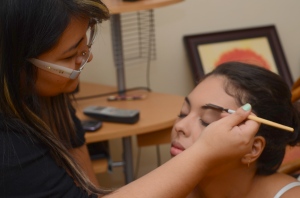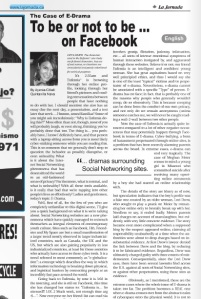The Quarter Life Crisis and the Emergence of Generation ‘Y’
By Ayenia-Citlalli Quintanilla Nava
(Originally Published in La Jornada News, London Ontario, May 1st 2009 issue)
I once heard of a modern proverb that goes something like this: “Youth is wasted on young…” And while one of my favorite pass times is to indulge in proverbial wisdom, this is definitely one I could not bring myself to agree with… not even a little. It is my opinion that this proverb is the expression of a problematic opinion which only broadens an already widened trans-generational gap. This gap lies at the root of many communication problems between the youth and the older generations. As a consequence, such mentalities and miscommunications leave us to suffer increased tensions within our families, at the workplace, and in everyday life.
Another issue I have with this proverb is that it sees ‘youth’ as an abstract temporal element which can only be possessed by a certain age group (this is not necessarily the case… I know plenty of youthful senior citizens!); and furthermore, it sees “the young” as a reckless age group undeserving of being bestowed with the very pleasure of being “young”. Therein lays another problem with the proverb… While it is incontestably the case that being young is a blessing, it should not be assumed, by any means that to be “young” is easy. Oftentimes we hear of the “Midlife crisis” and we accept it as part of a developmental rite of passage for adults…Other times we will hear of the “adolescent craze” of teenagers, and we understand they live turbulent hormonal lives which we must accept. Very rarely, however, will we see this same degree of comprehension and patience toward those people who fall in between…Today’s article will address one of the most pervasive problems affecting the youth of my generation… those who are caught between adolescence and “full” adulthood… this article is about the “Quarter-Life Crisis”.
To begin, the concept of the “quarter-life crisis” is not one I came up with on my own. It can be traced back all the way to the very foundations of Developmental Psychology, and to one of the most influential men in the field, Dr. Erik Erikson, who himself was somewhat influenced by Freud’s theory of developmental phases. Erikson is famous for having developed the eight-stage theory, in which he claims that at several moments in one’s life, a certain crisis will have to be resolved in order to proceed adaptively unto the next. For those aged 20 to 30 years old, Erikson claimed the main crisis to resolve revolved around relationships. He called it the: “Isolation vs. Intimacy” crisis, in which he explained that young adults look to move past superficial relationships and seek deeper connections with others, which usually result in marriage or other romantic commitments. While Erikson’s analysis is quite valid, it is incomplete because it focuses on a romantic level, and ignores other conflicts which young people face at this age.
In 2001, Abby Wilner & Alexandra Robbins (working together), and Damian Barr (in another part of the world), pioneered the movement of addressing the issue through books, articles and speeches across the internet (a tool which also defines our generation). Wilner & Robbins co-authored a book titled ‘Quarterlife Crisis, the Unique Challenges of Life in your Twenties’, and Barr wrote something similar, but with a deeper focus on “practical solutions”. He has also travelled and addressed many audiences on the issue, many of his speeches can be found on You Tube. Both publications address common symptoms which affect those who suffer the Quarter Life Crisis… among many they name deep feelings of insecurity toward the future, dissatisfaction toward the present, and a deep sense of regret or nostalgia toward the past. It is the phase of: “What will I do with my life?!” “What am I doing here?!” and “I should have…<insert regret here>…”
These questions are often product of a context in which the young person is leaving a stage of adolescent security, or “youthful bliss”… in which he or she felt sheltered, and is pushed into the shock of “the real world.” Often times, these are recent college or university graduates who feel distressed to find the skills they had invested so much energy on are not yielding their immediate desired results. They begin to wonder if it was even worth it… As Erikson predicted, these questions also have a tendency of spilling over to the realm of relationships, whether they be romantic or familial. At this point, the young person begins to revalue his or her life choices and relationships, enters the calamity of the Quarter Life Crisis. Furthermore, he or she begins to feel the pressure of “finding the one.” I know this is especially the case at family gatherings… especially mine.
Of course, I realize that their intentions are good, and that their questions and advice are only meant to help me, in what they think is that most practical solution to what they perceive to be an unstable life. I don’t blame them… at their age, and in their cultural context, a woman was much more limited to her life choices, and furthermore, to be unmarried at my age was worrisome for many. To be completely fair, it is still worrisome for many… not just young women, but also young men who feel the pressure to “find a good girl” and provide for their families. This sort of conflict can be observed much more insidiously among youth who grow up between the traditional/collective values of their parent’s past, and those individualistic ones we observe in our present context. It is not a question of which one is better… but rather a question of personal negotiation. For example, I may choose to marry young, (as did my brothers), but I can also choose to finish school while I am married (just as my sisters-in-law are doing). This is a choice which contains elements of both worlds. But before I go off on a tangent… let’s finish with the topic of the Quarter life crisis…
The research on the subject is very recent, making it a virtually unheard of phenomenon; nevertheless, it is catching on. It most likely that the augmented attention is due to the social emergence and recent empowerment of our generation, the Generation Y (the Baby Boom Echo) which is aging, entering the workplace, receiving promotions and arriving at this phase en masse. Because we are the children of the Baby Boom (a generation which itself defied social standards and provoked the cultural revolution of the century), we are a very populous demographic. That being said, it is now our turn to stand up for ourselves (and by ourselves) to prove to the generation which came before us, and will come after us that “Youth” is not actually “wasted” on the young, and that we are perfectly capable of surmounting the stresses we face. Furthermore, to those who are reading this, and are older, this is a great opportunity for you to realize that we, the young, are a reflection of your own hidden youth. This is the perfect time to rebuild those bridges, and to communicate, and to help each other through moments of adversity so that we may overcome the uncertainty of the future together, regardless of age.













